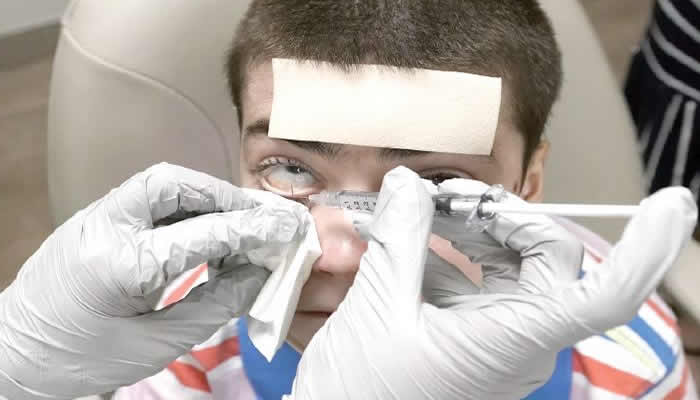
Year in, year out, several diseases, abnormalities and genetic conditions have left sufferers to lead unproductive lives, live with the stigma, pain and in some cases, meet their untimely death.
Studies revealed that genetic diseases affect people all over the world. The World Health Organisation estimated that between 70 and 80 million people lived with a genetic disease.
An international scientific publishing company, Nature Portfolio, stated that rare genetic diseases affected more than 300 million people worldwide.
Previously, most of these diseases were undiagnosed and consequently left untreated.
But advancements in technology and artificial intelligence as well as its introduction into healthcare are changing the narrative.
The introduction of novel health technologies and the use of Artificial Intelligence in the diagnosis and treatment of health conditions have offered a ray of hope and a second chance at life to persons living with life-threatening and changing illnesses.
Recently, through the help of genetic engineering, persons living with rare genetic-induced blindness can recover their sight through genetic therapy.
Genetic engineering, according to the National Human Genome Research Institute, is a process of using lab-based technologies to alter the DNA makeup of an organism.
DNA, known in full as deoxyribonucleic acid, contains the genetic information or material for the transmission of hereditary traits in humans and almost all other organisms.
Therefore, sicknesses that affect the genes are hereditary and can be passed from one generation to another.
To further stem the tide of continuous suffering of sicknesses, gene therapy, according to the School of Medicine, University of Missouri, United States, was being used for efforts to restore one’s health to normalcy.
Mayo Clinic explained that it involved altering the genes in one’s body cells to treat or stop diseases. In simple terms, gene therapy is replacing an abnormal body cell with a normal one.
Tweaking of genes may involve deleting a region of DNA, changing a part of the base pair, or adding a new gene from one species to another to produce a desired result.
Thus, genetic engineering which has been used in research and agriculture (genetically modified plants and animals) was now being used for new biomedical capabilities.
In July, the Associated Press reported how 14-year-old Antonio Carvajal, who was born with dystrophic epidermolysis bullosa, a rare genetic condition that caused blisters on his body and in his eyes, had his eyesight and skin restored after being treated through gene therapy.
Carvajal’s condition made his skin thin and filled with butterfly-like pigments and his eyes covered with scale-like films, making him blind.
Carvajal’s doctor, Dr Alfonso Sabater, was quoted to have said, “I’ll find a solution. I just need some time. I’m working on it.”
A cure for his skin condition was first achieved through gene therapy, leaving him to continue with his blindness.
Seeing that the skin condition had gone, the doctor then requested the pharmaceutical company to modify the drug into an eye drop so that it could be applied to the eyes.
AP stated, “Carvajal’s condition is caused by mutations in a gene that helps produce a protein called collagen 7, which holds together both skin and corneas. The treatment, called Vyjuvek, uses an inactivated herpes simplex virus to deliver working copies of that gene. The eye drops use the same liquid as the skin version, just without the added gel.
“After two years, which included testing the drug in mice, the team got “compassionate use” approval from the US Food and Drug Administration and permission from university and hospital review boards. Last August, Antonio (Carvajal) had surgery on his right eye, after which Sabater started treating him with the eye drops.”
After continuous usage of the eye drop for over a year, Carvajal’s eyesight improved and his doctor certified his vision, measuring close to 20/50, as “pretty good vision.”
Although the commonest cause of blindness is cataract, glaucoma and uncorrected refractive errors, over 4.25 million adults in Nigeria aged 40 and above, suffered moderate to several visual impairments or blindness.
Ophthalmologists stated that there was a high prevalence of blindness in the northern part of the country.
The WHO in 2022 warned of a spike in vision loss from 1.1bn in 2022 to 1.7bn in 2050.
Patients with diabetes and sickle cell were noted as being at risk of blindness, which could increase the burden of blindness in the country.
Explaining the process of Carvajal’s treatment, a professor of ophthalmology and the Provost, College of Health Science, Osun State University, Michaeline Isawumi, said, “After the doctor removed the scale covering the surface of the eye, he applied this gene therapy on the eye once in a month because it is something that has to be regulated. The gene therapy would either stop the abnormal skin from coming up or replace it with the new gene, causing the abnormality to disappear.”
She added that gene therapy worked based on genetic engineering and could be used to treat any congenital abnormality.
“In medicine, genetic engineering is the best way of treatment, because if you can identify the diseased part of the body or any abnormality, then it is replaced with the normal one. This can be known when a foetus is still in the womb or the part of the body which can be accessed and the DNA sequence is examined, the normal gene is then produced and applied to the part of the body.
“Gene therapy is the ultimate (treatment) in any part of the body, whether it is eyes or any other disease. If gene therapy can be done for any disease in this world, then everything will be replaced. The mechanism and how it works is that it would either replace a disease-causing germ or inactivate a gene that wants to cause any disease.”
Describing the innovation as possible and a welcome development to ophthalmic care, she stated that if a normal gene could be produced to replace the abnormal gene causing a genetic eye defect, such defect could be reversed.
The researcher on childhood diseases and blindness and community ophthalmology said, “If we have DNA sequencing and we can identify the abnormal gene in that area and the gene can be produced and the pharmaceutical company can describe how it can be delivered, then diseases may be reversed.”
However, she noted that such treatment was expensive and would take a long time before it could be adopted and or widely used.
She called for more research and production of genetic therapy drugs to enable the cure of all types of diseases.
On his part, the immediate past National President of the Guild of Medical Directors and a professor of Ophthalmology, Olufemi Babalola, stated that gene therapy was a novel approach to the treatment of diseases with a genetic origin.
He clarified that diseases without a genetic origin could not be treated with gene therapy.
The don said, “If someone has a cataract or glaucoma, gene therapy cannot be used because the mechanism of blindness is different. These two diseases account for 70 per cent of cases of blindness.”
He, however, noted that the usage of gene therapy in the cure of blindness was still in its experimental stages and the type of eye diseases that were amenable to gene therapy was currently limited.
Babalola further explained that less than 21 per cent of blind cases globally were caused by Carvajal’s condition.
He also noted, “Gene therapy has also been applied to other eye conditions, such as Retinitis pigmentosa (a group of rare eye diseases that makes cells in the retina break down slowly over time, causing vision loss) and age-related macular degeneration (an eye disease that is caused by ageing which affects the part of the eye that controls sharp, straight-ahead vision, causing blurry central vision).
“These are also causes of blindness but they are rare cases and not as common as glaucoma and cataracts. The application of gene therapy in patients with Retinitis pigmenetosa and AMD has recorded limited success, has not been universally successful and has not been used all the time. A lot depends on when you apply the gene therapy and what variant of the disease you are dealing with. As rare as these diseases are, they also have their variants.”
He stated that the potential application to the treatment of blindness was limited.
Other emerging technologies in ophthalmology
Speaking on emerging technologies currently used in ophthalmic care, Babalola said, “There is always ongoing research into novel therapies. One that seems to have taken up a bit is anti-vascular endothelial growth factor injection which is now commonly used in the treatment of patients who have diabetic retinopathy (an eye condition that can cause vision loss and blindness in people who have diabetes) and sickle cell retinopathy (the most common cause of vision impairment and blindness in individuals with sickle cell disease).
“Newer variants of the medication are produced every day. You might have one that can be implanted into the eye and serve as a relief to pain. That is the direction novel therapy is going.”
He stated that anti-VEGF therapy and implants were currently used in the country, adding that it could be further adopted.





